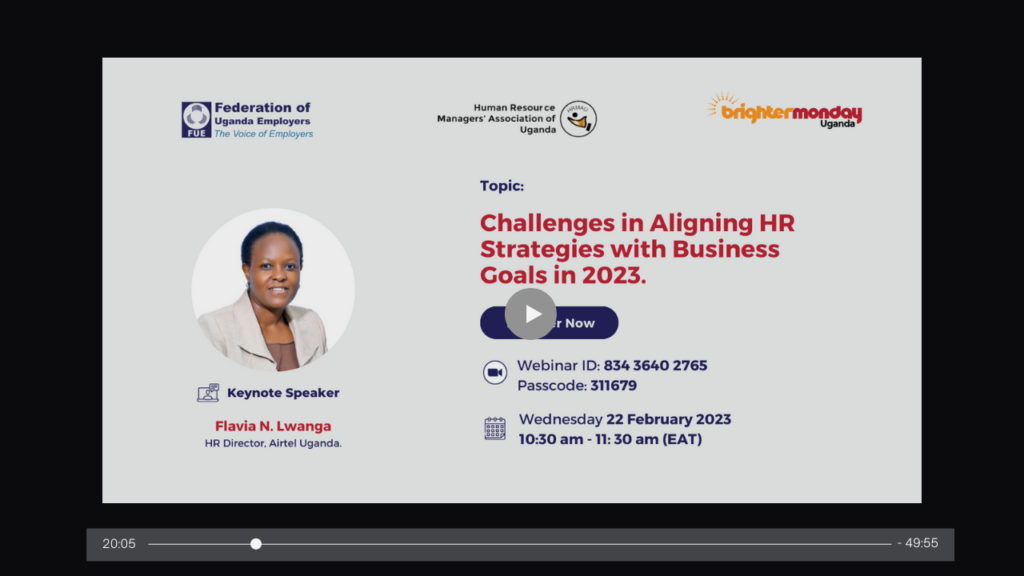At the recent webinar, HR Strategies: Aligning Business Goals with HR Strategies,
Guest speaker Flavia N. Lwanga, HR Director of Airtel Uganda, discussed the challenges of HR strategies and how they can be aligned with business goals.
She discussed key questions such as how HR can align its strategies with business goals, what HR trends will impact business strategy, and how can they be mitigated.
Table of Contents
1. The Importance of Alignment
The importance of alignment cannot be overstated. Companies must ensure that their HR strategies are in line with their business goals to maximize their potential for success.
When HR aligns its strategies with the goals of the business, it allows for improved communication, better resource allocation, and increased profitability.
Ultimately, this leads to better employee morale, increased customer satisfaction, and greater overall success.
2. How to Align Business Goals with HR Strategies
Here are some tips on how to effectively align your business goals with HR strategies:
- Identify your goals and objectives
- Develop a plan of action
- Create accountability
- Monitor performance
- Encourage collaboration
By following these tips, you can ensure that your business goals are aligned with HR strategies.
3. The Impact of HR Trends on Business Strategy
HR trends are constantly evolving, so it’s important for organizations to stay up to date on these trends in order to stay competitive in today’s market.
Technology and automation has changed the way HR departments conduct their work, from hiring, onboarding, employee engagement and performance management.
Additionally, the ever-evolving labor market requires employers to be more flexible and agile when it comes to recruitment and retention of talent.
Therefore, companies must focus on creating a diverse, equitable and inclusive culture in order to attract and retain top talent.
Link to the SLIDES: 👉 Click Here
Link to the VIDEO here: 👉Click Here
Passcode: G*P8rK4g

Q&A with Flavia N. Lwanga
On February 22nd, Flavia Lwanga, HR Director at Airtel, presented on how to align business goals with HR strategies. During her presentation, attendees asked several questions about the topic.
Here is what Flavia had to say in response to some of those questions.
Q: What advice do you have for HR professionals looking to align their strategies with their company’s goals?
A: My advice to HR professionals is to start by understanding the company’s goals and objectives. Once they are clear on that, they can then create HR strategies that are tailored to help achieve these goals. It is important to take into account the current trends in the industry and to have an open dialogue with all stakeholders within the organization. Additionally, it is important to be agile and responsive to changes to ensure the success of any HR strategy.
Q: How do HR trends affect business strategy?
A: HR trends have a significant impact on business strategy. For example, the rise of remote working has caused many companies to re-evaluate their existing policies and create new ones that better support remote workers. Similarly, increased diversity and inclusion initiatives have led many organizations to reconsider their recruitment processes and work culture. By understanding the current HR trends, businesses can ensure that their strategies remain relevant and effective in a constantly changing environment.
Q: What steps can businesses take to mitigate any risks associated with HR trends?
A: To mitigate the risks associated with HR trends, businesses should strive to be proactive rather than reactive when it comes to making changes. For example, businesses should review their existing policies regularly to ensure they remain up-to-date and compliant with any new regulations or standards. Additionally, it is important to provide adequate training and resources for employees to help them adapt to any changes that may be necessary. Finally, businesses should consider conducting research and surveys to gain insights into how their employees feel about any proposed changes. This can help identify potential issues before they arise and make sure that any changes are implemented successfully.





